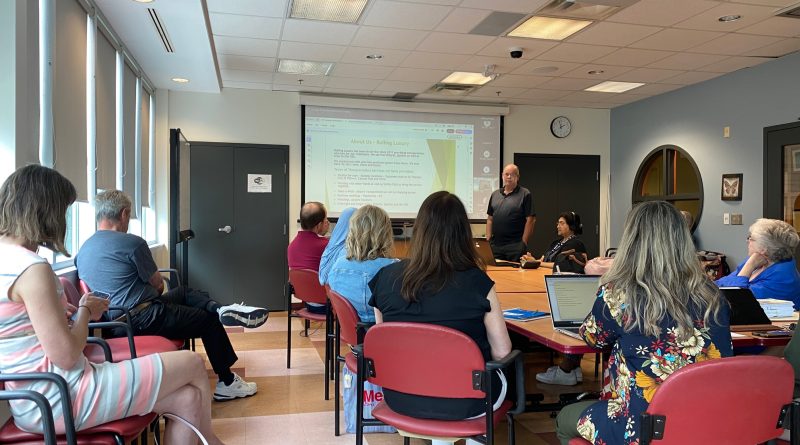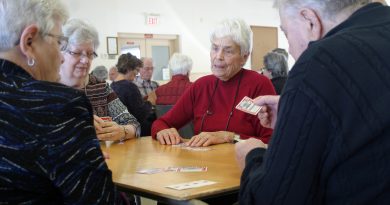RTS drives Ward 5 bus proposal
By Nonie Smart - West Carleton Online
KANATA – A private venture bus proposal for Ward 5 was on the table last week (July 9) hosted by the community-based group Rural Transportation Solutions (RTS) for Ottawa.
Local stakeholders gathered in a boardroom at the Western Ottawa Community Resource Centre (WOCRC) headquarters for the pitch.
Ken Holmes co-lead of RTS put the wheels in motion around 1:30 p.m. with a welcome to the roughly 26 attendees. West Carleton Online recognized Ward 5 community leaders Greg LeBlanc, co-chair, the Village of Carp Business Improvement Area (BIA), Roddy Bolivar, executive director, Carp Road Corridor Business Improvement Area (CRCBIA), two staffers from Ward 5 Coun. Clarke Kelly’s team and a representative from the Huntley Community Association (HCA) in the audience.
Although it may be a challenge to implement rural public transportation in a city with the largest geographical area in Canada, Holmes says it can be done.
“We are not unique,” Holmes said. “Many other cities have large rural areas but they have been able to come up with transportation solutions. One of the things we (RTS) are constantly reminded of is, if these communities can solve their problems, why can’t we?”
The RTS formed five years ago in response to the need for affordable, and sustainable rural transportation (for past coverage of RTS, click here). Since that time, it has been compiling data; researching innovative solutions; and using every opportunity to keep their issues on the city’s radar.
“We have been persistent in our advocacy and in ensuring the City of Ottawa is applying the rural lens whenever transportation issues are discussed,” Holmes said. “The Rural Summit last November (2024), also provided us with an excellent opportunity to advocate again for rural transportation issues. We made it on their short list actually.”
One of the main challenges of providing affordable rural public transit is figuring out how to serve a small population dispersed over a large area. In Ottawa, 10 per cent of the city’s rural population are distributed over 80 per cent of its land mass.
“There are 27 rural villages scattered through our non-urban area,” Holmes said. “Today more than one half of them still have no access to public transit.”
Not much has changed since the city amalgamated in 2000.
“The single comprehensive rural transportation study our city has conducted was in 2002,” Holmes said. “To the best of our knowledge that is the one and only study done on transit since the City of Ottawa amalgamation.”
The RTS has used data from heat maps to visualize the population distribution in West Carleton and also tapped into survey information for insights on the travel habits of residents.
Shopping, according to the most recent National Capital Region destination study, is the primary reason Ward 5 residents travel, while work, recreation and health care rate as lower priorities. This study also showed 26 per cent of the trips that start in Ward 5 stay in Ward 5 while 33 per cent of those that leave our boundaries go to Kanata and Stittsville.
Holmes says any potential bus service would also have to efficiently serve both busy and off-peak travel times.
“Any solution we have that is reasonable and affordable has to as quickly and efficiently as possible get our passengers in the OC Transpo system,” Holmes said. “We need to collect people from the villages and from between villages in West Carleton and get them to a hub. Then we have done our job.”
Jerry Pearson, CEO of Rolling Luxury says his private transportation company is ready to do just that.
Based out of Ottawa and Buckingham, QC, Rolling Luxury has been operating in Ontario and Quebec since 2011. It also currently provides contract services to the likes of OC Transpo and other local organizations.
“What I want to do is provide a fixed route bus service to as many of the residents in Ward 5 as possible,” Pearson said. “I have been working with Ken Holmes to see about some routing that would cover the biggest populations. My biggest goal is to get bus stops where you are going to have maybe 10 minutes at most to walk to a stop.”
The plan proposes four buses running two fixed routes that could cover 90 per cent of Ward 5 and connect people with OC Transpo in Kanata.
Pearson says the operation would require an annual input of $ 2.5 million from outside funding sources in addition to the collection of proposed fares of $3 per trip, $10 per day and $100 per month. Once a year the community would receive a payback from the company of 10 per cent of the total fares.
“We are just trying to make things affordable,” he said.
Attendees queried logistical details, the funding model and the possibility of a staged implementation, in particular, during the lively question period that followed.
As far as operational details go, Holmes said things are still very much in the planning stages – all possibilities (fixed route versus on-demand service, routing, bus stop locations, and so on) are up for discussion.
“We will choose whichever model best fits demand,” he said.
Holmes said they have yet to investigate government funding opportunities as one way to cover the annual $2.5 million input.
LeBlanc suggested funds from the proposed Marchurst Battery Energy Storage System (BESS) community fund might be a possible source, at least for a start. He added the local BIAs are trying to do everything to encourage some sort of (transit) solution. They see a huge economic development potential on the Carp Road Corridor but workers can’t get there.
“It’s a problem,” LeBlanc said. “We have 77 employees (at Carp Commons) that have to park somewhere in Carp.”
Although Pearson says he is, “ready to go, yesterday,” it’s unclear when rural bus service will come to West Carleton. Holmes, who was also a former Ward 5 Rural Summit resident working group representative in 2024, says he thinks the best way to move rural transportation issues through the system is to build on the city’s policy commitments.
“We don’t have a year yet (for implementation), so much depends on the priority the Rural Summit gives it and how the city responds to its new improved Transportation Master Plan,” he said. “That gives us some idea of what priority the city will apply to that particular need. It’s impossible to say when.”
LeBlanc suggested there might be an advantage to starting with a scaled down plan.
“I think the biggest commute would be the Carp Road Corridor,” he said. “It’s such a big employment zone and the village. Staring with a much smaller number might just show how viable it is for just that section because West Carleton is so spread out. There is a divide between Carp Road and the village, and the rest of West Carleton. That might make a lot more sense than starting with all of Ward 5.”
For more information on RTS including a copy of the July 9 presentation see: www.rural-transportation-solutions-for-ottawa.info.













Thank you Ken and company for all your consistent work and dedication!